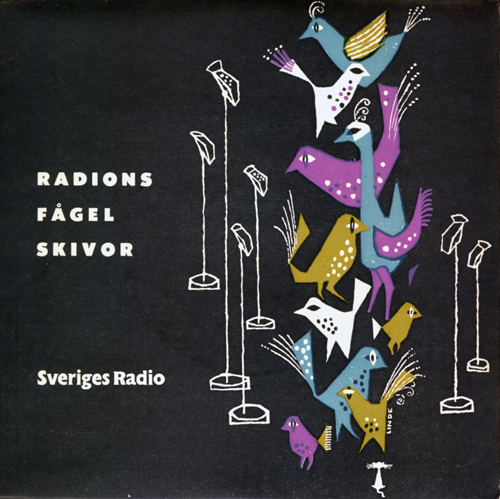Radions Fågel Skivor -collection-
STURE PALMÉR and other uncredited crew
(The Swedish Broadcasting Corporation 1958-67)
Review / research by Cheryl Tipp
From 1958-1967, The Swedish Broadcasting Corporation, then known as Sveriges Radio, published a series of birdsong EPs under the title Radions Fågel Skivor (Radio Bird Records). These 45 rpm discs, 40 in total, presented the songs and calls of 292 birds occurring in Sweden and were part of a Swedish natural history publishing programme that began in 1936.
Initially driven by the need to develop an archive of wild bird songs and calls, recorded in the field, for broadcasting purposes, the team at Sveriges Radio decided to produce a set of five educational discs for distribution to Swedish schools. With no way of cutting discs in the field, recordings were transmitted along telephone wires to an awaiting disc cutting machine in broadcasting headquarters. In the article Wildlife Recording by Swedish Broadcasting Corporation (Recorded Sound, 1969), Sveriges Radio engineer and recordist Sture Palmér, wrote “you had to keep one hand over the disc-cutting machine and the telephone in the other”. Though successful, the results were by no means perfect; poor signal transmission and interruptions from line-twitter meant that “a nightjar, for instance, sounded like a compressed-air drill”. Despite this, five discs were published at Christmas 1937 and featured the first Swedish recordings of wild birds (Radiotjänst 1-5).
In 1938 the company obtained their first mobile recording van which significantly improved their recording efforts, so much so that a continuous recording programme was instigated. The original recordings were replaced with higher quality examples that, along with many new recordings collected, formed the basis of a series of sixty five curated discs covering 183 Swedish species and released on a regular basis until the close of 1956 (Radiotjänst 6-70).
The evolution of recording technologies and the development of carriers capable of holding an increasing amount of content offered many new possibilities. It was however the emergence of the parabolic reflector that became the deciding factor in Sveriges Radio’s resolution to embark on a new series of bird records. The directional nature of the reflector meant that clearer, cleaner vocalisations could be recorded. Thus Radions Fågel Skivor was born.
7 species on average were featured per disc; detailed descriptions of the vocalisations heard were included on the sleeve reverse and though most of the text was written in Swedish, Latin names were included for non-Swedish speakers. Unlike other EP series published around the same time (e.g. Stimmen Einheimischer Vögel from Kosmos and Jean-Claude Roché’s Guide Sonore des Oiseaux d’Europe), the aesthetic style remained unwaveringly consistent. A black sleeve decorated with bird illustrations reminiscent of Russian avant-garde art became the signature look of this ambitious series.
Most recordings were made by engineer Sture Palmér, who by this time had taken over sole responsibility for Sveriges Radio’s field recording programme. His experience on the original Radiotjänst series, initially as a recordist working under the guidance of Gunnar Lekander and then as both recordist and project leader, equipped him with all the necessary skills to successfully oversee a project of this scale. Over 80,000 EPs had been sold when the series came to an end in 1967 and the success was such that Palmér soon embarked on another series, this time looking beyond Sweden to take in the birdlife of Europe. Collaborating with the BBC and around 50 other organisations and individuals, A Field Guide to Bird Songs of Britain and Europe again upped the ante by almost doubling the number of species represented. These were then offered as a series of fourteen LPs.
Looking back at the publishing story of Sveriges Radio one is struck by the patience, dedication and determination of individuals such as Sture Palmér and Gunnar Lekander. There was absolute commitment to developing and completing these long running series while constantly trying to improve recording techniques and audio quality. Almost without fail copies of publications from Radiotjänst, Radions Fågel Skivor and A Field Guide to Bird Songs of Britain and Europe appear in record collections, so much so that a complete copy of each series, from 1937 onwards, is now archived for generations to come at the British Library Sound Archive.
[Photo courtesy of Resume]



